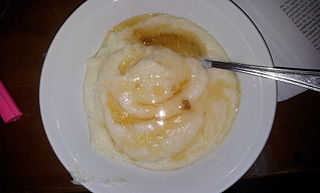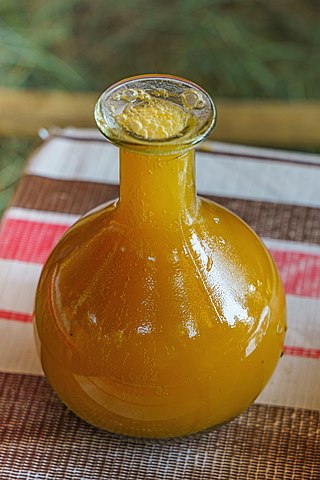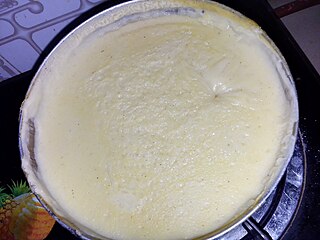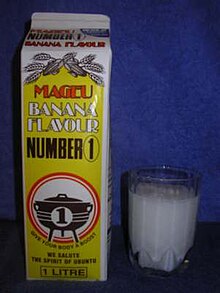
Lactic acid fermentation is a metabolic process by which glucose or other six-carbon sugars are converted into cellular energy and the metabolite lactate, which is lactic acid in solution. It is an anaerobic fermentation reaction that occurs in some bacteria and animal cells, such as muscle cells.

Mămăligă is a porridge made out of yellow maize flour, traditional in Romania, Moldova and West Ukraine. Poles from the Lviv area also prepare this traditional dish. It is also a traditional dish in Thessaly and Fthiotis, Greece, and is also common in the Black Sea region of Turkey. In Italy, Switzerland, Slovenia, Croatia, and many other countries, this dish is known as polenta.
Cauim is a traditional alcoholic beverage or beer of the indigenous peoples in Brazil since pre-Columbian times. It is still made today in remote areas throughout Panama and South America. Cauim is made by fermenting manioc, or maize, sometimes flavored with fruit juices. The Kuna Indians of Panama use plantains.

Ethanol fermentation, also called alcoholic fermentation, is a biological process which converts sugars such as glucose, fructose, and sucrose into cellular energy, producing ethanol and carbon dioxide as by-products. Because yeasts perform this conversion in the absence of oxygen, alcoholic fermentation is considered an anaerobic process. It also takes place in some species of fish where it provides energy when oxygen is scarce.

Zimbabwe has many different cultures, which may include beliefs and ceremonies, one of them being Shona. Zimbabwe's largest ethnic group is Shona.

South African cuisine reflects the diverse range of culinary traditions embodied by the various communities that inhabit the country. Among the indigenous peoples of South Africa, the Khoisan foraged over 300 species of edible food plants, such as the rooibos shrub legume, whose culinary value continues to exert a salient influence on South African cuisine. Subsequent encounters with Bantu pastoralists facilitated the emergence of cultivated crops and domestic cattle, which supplemented traditional Khoisan techniques of meat preservation. In addition, Bantu-speaking communities forged an extensive repertoire of culinary ingredients and dishes, many of which are still consumed today in traditional settlements and urban entrepôts alike.
African cuisine is a staple of the continent's culture, and its history is entwined with the story of the people of Africa. The foods that Africans eat have been influenced by their religions, as well as by their climates and lifestyles. The first Africans to inhabit the continent were hunter-gatherers who ate what they could find in nature. As agriculture became more common in Africa, so did agriculture-based diets.

Ugali or posho or sima is a type of corn meal made from maize or corn flour in several countries in Africa. Sima is sometimes made from other flours, such as millet or sorghum flour, and is sometimes mixed with cassava flour. It is cooked in boiling water or milk until it reaches a stiff or firm dough-like consistency. In 2017, the dish was added to the UNESCO Representative List of the Intangible Cultural Heritage of Humanity, one of a few foods in the list.

Mielie meal, also known as mealie meal or maize meal, is a relatively coarse flour made from maize or mealies in Southern Africa, from the Portuguese milho. It is also known by various other indigenous language names depending on the locality or country. It was originally brought to Africa from the Americas by the Portuguese.

Purposeful production of alcoholic drinks is common and often reflects cultural and religious peculiarities as much as geographical and sociological conditions.

Tej is a honey wine, like mead, that is brewed and consumed in Ethiopia and Eritrea. It has an alcohol content generally ranging from 7 to 11%. It is often home processed and consists of three main ingredients; honey, water and a medicinal shrub called "gesho". Tej is also available commercially to buy in many different types. It is generally consumed during social events such as festivals or weddings, and religious events like Ethiopian New Year (Enkutatash). Consequently, Tej forms an important part of Ethiopian society and culture and is considered the national drink of Ethiopia.

The cuisine of Botswana is unique but shares some characteristics with other cuisines of Southern Africa. Examples of Setswana food include pap, samp, vetkoek, bogobe and mophane worms. A food unique to Botswana is seswaa, salted mashed-up meat.

Ghanaian cuisine is the cuisine of the Ghanaian people. Ghanaian main dishes are organized around a starchy staple food, which goes with a sauce or soup containing a protein source. The main ingredients for the vast majority of soups and stews are tomatoes, hot peppers and onions. As a result, most of the Ghanaian soups and stews are red or orange in appearance.

Ogi is a fermented cereal pudding and popular street food from Nigeria, typically made from maize, sorghum, or millet. Traditionally, the grains are soaked in water for up to three days, before wet-milling and sieving to remove husks. The filtered cereal is then allowed to ferment for up to three days until sour. It is then boiled into a pap, or cooked to make a creamy pudding also known as Agidi or Eko. It may be eaten with moin moin, akara/acarajé or bread depending on individual choice.

In food processing, fermentation is the conversion of carbohydrates to alcohol or organic acids using microorganisms—yeasts or bacteria—under anaerobic (oxygen-free) conditions. Fermentation usually implies that the action of microorganisms is desired. The science of fermentation is known as zymology or zymurgy.

Amasi, maas, or mafi, is a fermented milk product that is similar to cottage cheese or plain yogurt. It is a popular snack in South Africa and Lesotho.

Commercial sorghum is the cultivation and commercial exploitation of species of grasses within the genus Sorghum. These plants are used for grain, fibre and fodder. The plants are cultivated in warmer climates worldwide. Commercial Sorghum species are native to tropical and subtropical regions of Africa and Asia.















